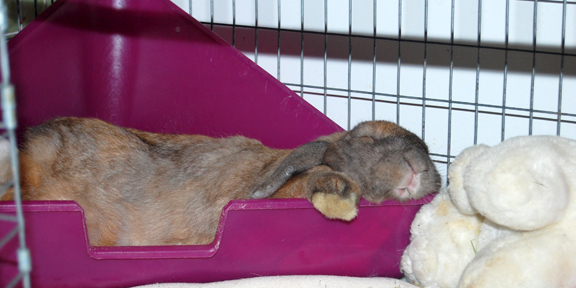
It should come as no surprise how easy it can be to litter train a rabbit given that they are by nature very clean animals and so intelligent!
Spaying/Neutering
This is usually the key to a successfully litter trained rabbit.
Hormones often results in “marking” of territory with both faeces
and urine. Both males and females can spray to mark territory
once they mature at around 4-6 months.
Type of litter
This is a crucial aspect for rabbits. Many litters are just not safe for rabbits. Clay or any clumping litter can be extremely dangerous if a rabbit were to ingest any, and can even lead to death. Deodorant crystals in many cat litters are toxic.
Litters or shavings made from pine or cedar may cause liver or respiratory damage. Swheat Scoop litter, if eaten can cause a slew of health concerns. Corn cob bedding is also often ingested causing numerous health problems, including death, and can get moldy when wet. Mold is toxic to rabbits.
So what type of litter is safe to use? Newspaper based litters such as MewsPrint or Yesterdays News are compressed into pellet form an highly absorbent. Carefresh bedding also made from paper pulb is a bunny safe option. Some people prefer using Wood Stove Pellets, which are an inexpensive option. They are safe beause the phenolic compounds are removed during their manufacture. We find they do not absorb urine as well, and become crumbly (like sawdust) when wet. For rabbits with respiratory illness this is not the best choice.
How to litter train
Place a litter box filled with appropriate litter (and possibly a handful of hay) in your rabbits enclosure/cage and at least one in the room where they run around. Your bunny may tell YOU where he or she would like the litter box! If he/she goes in a particular corner, then move the litter box to that location. When she uses the litter box, praise her or give her a little treat. Positive reinforcement always works better than negative! (ie rewards for getting it correct, not punishment for getting it wrong).
You can sweep up faeces and put them in the litter box, and even soak up urine with a paper towel and place it in there as well. Very quickly they will realize that the litter box is the bathroom! Gently place your rabbit in the box, or herd her towards it if you think she is going to urinate. Once she goes in it a few times, she is well on her way to begin litter trained.
No longer using the litter box
If your rabbit suddenly stops using the litter box, or starts to dribble urine it could be time for a vet visit. Often dribbling urine could indicate a medical issue such as a bladder or urinary tract infection or a stone. Both can be quite treatable when caught early. Left unattended to, a bladder/kidney infection can actually lead to kidney disease.
Or no longer going in the box could also indicate other issues, such as not being physically able to get into the box (for reasons such as arthritis, spondolosis). Once diagnosed, a rabbit may be on medications, and you can alter your litter box to accommodate your friend. Many owners wind up cutting down a side of their litter box (and filing it smooth, or placing duct tape over it so there are no sharp edges) so that the rabbit can easily walk in, rather than hop.
Often times, loosing litter habits to a once perfectly trained rabbit is not medically related but environmental. Consider any changes that may have happened that could affect your rabbit – new house, new rooms, new pets, a loss of a pet or loved owner.
Having difficulty litter training your rabbit?
Talk to your vet who can help pinpoint any medical causes and offer suggestions if it is a behavioural situation.






